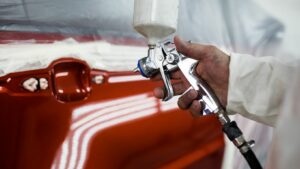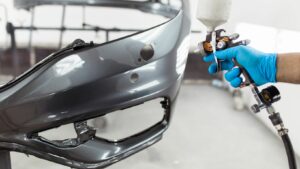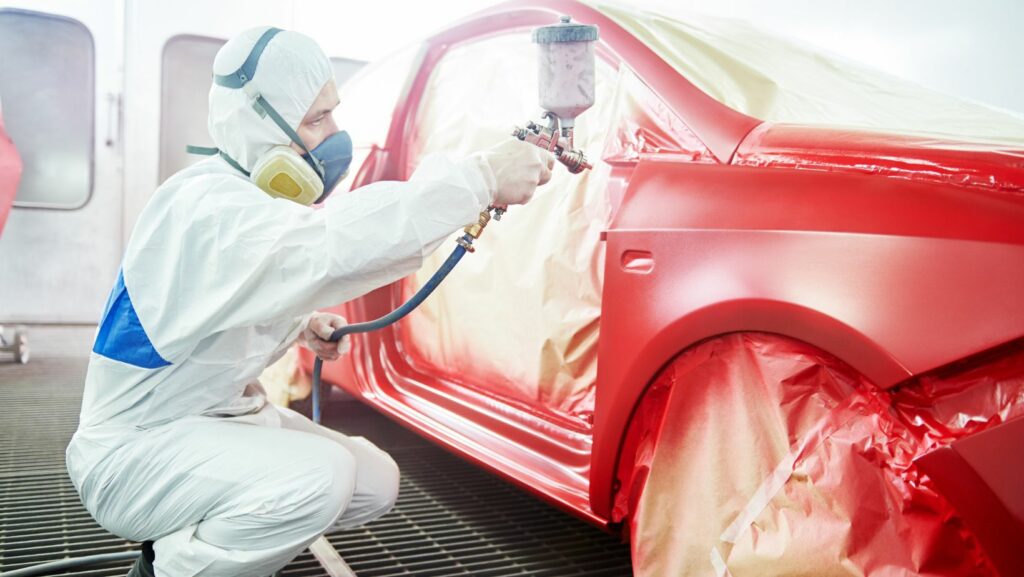Picture a smooth, glossy, and flawless paint job on a car. It’s the kind that turns heads and makes a statement. But behind that perfect finish is a lesser-known hero, the automotive primer. This unsung component plays a critical role in achieving that eye-catching look.
Automotive primers aren’t just about aesthetics, though. It’s also about protection. It safeguards the car’s metal surfaces from rust, corrosion, and the harsh effects of weather. But how does it work? And why is it so vital in the automotive paint process?
Automotive Primer
 Automotive primer serves as an intermediary, facilitating adhesion between the vehicle’s bare metal surface and the paint. Aside from binding features, it’s also up to the primer to ensure a smooth texture for the topcoat. Its intricate functionality doesn’t end here, though. Primers carry the responsibility of shielding the car’s metal body from deterioration agents, including corrosion, rust, and environmental impacts.
Automotive primer serves as an intermediary, facilitating adhesion between the vehicle’s bare metal surface and the paint. Aside from binding features, it’s also up to the primer to ensure a smooth texture for the topcoat. Its intricate functionality doesn’t end here, though. Primers carry the responsibility of shielding the car’s metal body from deterioration agents, including corrosion, rust, and environmental impacts.
Types of Automotive Primers
There exist numerous types of automotive primers, each designed for a specific function and application. A brief overview of these types provides insights into their unique roles in vehicle painting:
- Epoxy Primer: This primer earns distinction for its significant rust resistance, making it an ideal choice for cars susceptible to rust development.
- Urethane Primer: Exhibiting excellent fill properties, the urethane primer helps in masking minor surface imperfections before applying the topcoat.
- High-build Primer: As its name suggests, high-build primer has a thicker consistency. It’s frequently utilized to correct larger surface flaws.
- Self-etching Primer: This primer possesses acidic additives that allow it to etch into the metal surface, fostering remarkable adhesion.
Each primer variant holds a set of unique characteristics, designed to cater to different surfaces, purposes, and specific automotive conditions.
Benefits of Using Automotive Primer
The implementation of automotive primer provides numerous advantages that extend beyond aesthetic enhancement.
Improved Adhesion
 Automotive primer serves a key role in bolstering the adhesion between the car’s metal surface and paint. It offers a smooth and stable groundwork layer eagerly bonding with both the metal surface and the paint. On the application of paint directly onto a surface, poor adhesion instances may occur. However, when the primer is applied first, it firmly adheres to the underlying metal surface (for instance, the car body), offering a suitable base for the paint which in turn results in better adhesion.
Automotive primer serves a key role in bolstering the adhesion between the car’s metal surface and paint. It offers a smooth and stable groundwork layer eagerly bonding with both the metal surface and the paint. On the application of paint directly onto a surface, poor adhesion instances may occur. However, when the primer is applied first, it firmly adheres to the underlying metal surface (for instance, the car body), offering a suitable base for the paint which in turn results in better adhesion.
Corrosion Resistance
Equally essential in the list of benefits is the role of automotive primer in defending against corrosion. Automotive bodies are consistently at stake concerning rust formation due to exposure to moisture and air. Applications such as an Epoxy Primer work wonders in presenting rust resistance thereby circumventing the early onset of corrosion and extending the vehicle’s life span. For instance, a car left without primer in a humid environment can fall victim to severe rust issues in no time, amplifying the importance of primer’s role in combating corrosion.
How to Apply Automotive Primer
Automotive primer application is an essential step in the car refinishing process. Experts recommend two primary stages: preparing the surface and mastering application techniques.
Preparing the Surface
 The surface preparation process begins with adequate vehicle cleaning. Remove dirt, wax or any grease using an appropriate cleaning solution. Drying the vehicle topped the list, ensuring a moisture-free environment for the primer. Removal of rust and old paint follows thereafter, using a sandpaper or a power sander depending on the level of detailing required. Upon achieving a smooth texture, it’s time to mask off areas not meant for priming.
The surface preparation process begins with adequate vehicle cleaning. Remove dirt, wax or any grease using an appropriate cleaning solution. Drying the vehicle topped the list, ensuring a moisture-free environment for the primer. Removal of rust and old paint follows thereafter, using a sandpaper or a power sander depending on the level of detailing required. Upon achieving a smooth texture, it’s time to mask off areas not meant for priming.
Application Techniques
When it comes to application techniques, accurate product mixing takes precedence. The ratio of primer to catalyst varies depending on primer type and manufacturer instructions. An undermixed product compromises adhesion, overmixed ones become too sticky too soon. A paint sprayer earns the crown for application, offering a uniform layer compared to paintbrushes or rollers. Holding the sprayer at a consistent distance ensures even coverage. Always aim for thin, multiple coatings rather than a single, heavy coat. Ideally, drying intervals in between layers prevent drips and runs. Lastly, a final sanding post application can provide a perfectly smooth surface for the upcoming paint layer.



